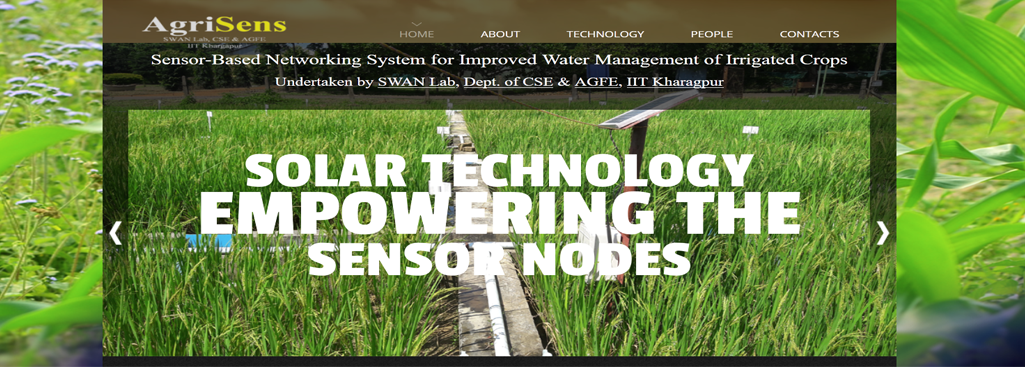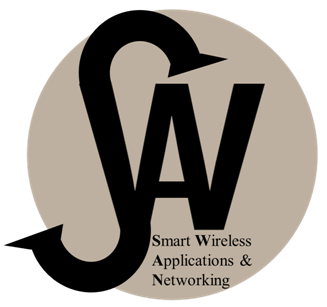AgriSens: Sensor-Based Networking System for Improved Water Management of Irrigated Crops
|

|
This invention, AgriSens, is a webserver-based platform for water monitoring and controlling of irrigated fields using an automated real-time system based on WSN. AgriSens is usable in agricultural fields with heterogeneous crops. AgriSens offers a farmer-friendly interface, so that a farmer can feel the actual field situation and can take the proper decision confidently. In the system, the end-users as farmers are completely abstracted from the underlying logic for processing, retrieving, and provisioning. As the system cost is low, the farmers can use the innovative technology in their fields to increase productivity as well as to protect the environment. The primary advantage of AgriSensis that, unlike the existing traditional WSNs, it enables the farmers to enjoy the service without going to the field remotely.
http://agrisys.iitkgp.ac.in
|
AmbuSens: Ubiquitous Healthcare Monitoring for the Connected Era
|

|
The AmbuSens ubiquitous healthcare monitoring system is a framework to bring about the next step in healthcare monitoring. The AmbuSens framework utilizes the cutting edge in Wireless Medical Sensing as well as IT infrastructure, to create an interface that allows users to have instant anytime, anywhere access to real-time medical data.
http://ambusens.iitkgp.ac.in
|
Underwater Wireless Acoustic Sensor Nodes for Multimedia Streaming
|

|
The implemented underwater wireless acoustic sensor nodes can easily stream multimedia data like the image from a sender node to receiver node covering a distance of 67 meters underwater with a data rate of 3.5 kbps. The intermediate nodes are implemented to enlarge the coverage range further. The nodes (transmitter, receiver, and intermediate) consume less energy up to 2.5 mJ and provide a better quality of received images in terms of SSIM.
|
Jaltarang: A NS-3 based Underwater Sensor Network Simulator
|

|
Jaltarang is Network Simulator (NS-3) based simulator for underwater Sensor Networks. It is developed based on NS-3.14, and the simulator can be installed on top of the NS-3. Jaltarang can be operated from a easy to use GUI or from the command line. The salient features of the simulator are listed below.
- GUI/Command line access
- Topology Module
- Localization module
- Physical layer
- MAC layer
- Network layer
- Mobility module
- Visualization module
- Trace file and command-line/file output
|
MAcoSim: Matlab-based Acoustic Underwater Simulator
|

|
MAcoSim is a MATLAB based simulator for Underwater Sensor Networks. MAcoSim is operated by both GUI and MATLAB command line interface. The following are the salient features of the simulator.
- DES Core
- Centralized parameter manager
- Topology Module
- Localization module
- Physical layer
- MAC layer
- Network layer
- Mobility module
- GUI and command-line input
- Trace file and command-line/file output
|
Generic Wireless Sensor Network Kit v1.0
|

|
The sensor node developed for the Generic Wireless Network Kit consumes low power and is flexible with respect to functionalities. The board can be easily programmed by the users. User-specific algorithms can be implemented in the sensor board.
N.B.: Upcomming versions v1.1 and v2
|
Physiological Wireless Sensor Network Kit
|

|
The low-cost physiological sensor network kit developed by the SWAN Group can be used for automated remote monitoring of different physiological parameters of patients, such as blood oxygen saturation, air-flow, body temperature, cardiac signals, and heart-rate. Communication of body signals occur over wireless medium using ZigBee and WiFi standards. The entire system is wearable.
|
Big-Sensor-Cloud Platform
|
The development of Big-Sensor-Cloud Platform immensely enhances the usability and management of the physical sensor devices. Traditional Wireless Sensor Networks (WSNs) are manufactured in a proprietary, vendor-specific design, and cannot handle application switching dynamically at runtime due to the presence of monolithic kernel. Sharing of data is also non-trivial, as the WSN owners generally do not want to share their data to an external user in order to maintain security. Consequently, the renderability of WSNs is almost infeasible to people/organizations that do not own a network of their own. Thus, in the existing system, WSN-based applications are inaccessible to the naïve-users or common people who do not own physical sensor devices. Of late, sensor-cloud infrastructure has been viewed as a substitute for traditional WSNs
|
Agricultural Wireless Sensor Network Kit
|

|
Our Agricultural Sensor Network platform is developed for multi-purpose use in the field of Agriculture such as for water-level monitoring, soil-moisture content, pump actuation and intruder detection. The system is powered by renewable sources of energy. Additionally, the system supports special features such as sending SMS alert to the farmer’s cell phones informing various field parameters. Along with the sensor board development, low-cost water-level sensor has been developed by the SWAN Group.
|
Smart-Grid Educational Platform
|

|
An educational smart-grid platform has been developed by the SWAN Group. This product helps the users in supplying energy without having a complex architecture at their end. In traditional smart grid, the users get power supply as per their requests, while paying high price, or by waiting for a significant duration, in order to get uninterrupted supply in the on-peak hours
|
Virtual Labs for Software Engineering
|

|
The Software Engineering Virtual Lab covers popular topics on the subject catering to the university syllabi and provides a workspace to the students to have hands-on practice. This lab teaches ER modeling, various UML diagrams, cyclomatic complexity, test suite design and other topics. Various software including Graphviz and PlantUML have been used at the back end. The workspace has been designed in such a way so that the students can understand the basic concepts and building blocks, rather than simply drawing some diagrams.
http://vlssit.iitkgp.ernet.in/isad/isad
|
Virtual Labs for Advanced Network Technologies
|

|
The Advanced Network Technologies Virtual Lab deals with advanced topics in computer networks. This lab helps the students understand the basic concepts of each topic through remote network simulations using two simulatos – NS-2 and NS-3.
http://vlssit.iitkgp.ernet.in/ant/ant
|
Dual-Medium Wireless Sensor Network test-bed
|

|
The dual-medium WSN test-bed operates over 2.4Ghz wireless spectrum by transmitting various sensor data from three slave nodes to a central master node. In case of link failure or jamming attacks, the system detects the failure in communication link and switches over to acoustic data transmission. Various data such as text, audio and video have been successfully transmitted using this test-bed.
|
R2D2: Rotating-turret 2D-scanning and Dead-reckoning platform
|

|
The R2D2 system makes use of 2D acoustic scanning, enhanced with dead reckoning systems to navigate unchartered and disaster affected areas. The system remotely generates a fusion map which enables the remote operator to visualize the rover’s operating terrain. The R2D2 data being sent over resource-constrained wireless networks can work under all lighting conditions, including pitch darkness.
|
Unmanned Aerial Platforms for Agriculture
|

|
The low-cost UAV platforms are being worked upon, keeping in mind the specialized needs and requirements for agriculture. Various strategies for implementing a networked UAV swarm and control o0ver wireless networks is being explored using these systems. The additional aspect of low-altitude remote sensing for agriculture is being worked upon.
Video Link: https://www.youtube.com/watch?v=Y8PNR9PXO8c&feature=youtu.be
|
Smartphone Apps for Physical Activity Sensing over Wireless Networks
|

|
The R2D2 system makes use of 2D acoustic scanning, enhanced with dead reckoning systems to navigate unchartered and disaster affected areas. The system remotely generates a fusion map which enables the remote operator to visualize the rover’s operating terrain. The R2D2 data being sent over resource-constrained wireless networks can work under all lighting conditions, including pitch darkness.
|
Low Cost Internet of Things Node
|

|
The low-cost IoT node can be easily reconfigured for a wide variety of applications, ranging from indoor use to outdoor use. The data from these nodes is transmitted wirelessly to a remote server which hosts an analytics and decision engine. The node can be easily controlled using a smartphone . The cost of assembling a single node is approximately INR 2500. The cost goes up with the sensors being used with the node.
|

